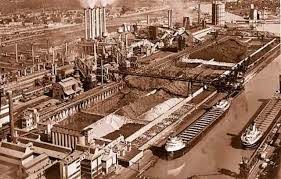 |
| Russian immigrants waiting on Ellis Island. |
 |
| Street punks waiting for some action. |
 |
| Purple Gang members avoiding a press photograph at the 13th Precinct police station. |
The Purples came about through the merging of two groups--Oakland County's Sugar House Gang led by Leiter and Shorr, and a mob of Jewish street hoods led at that time by nineteen-year-old Sammy Coen, who assumed the alias Sammy Purple. Detroit detective Henry Gavin claimed the gang was named after Sammy. Once the police tagged the group as the Purple Gang, the press took up the drum beat. Gang members hated the label. There are several urban legends about how the gang's name came about, but Henry Gavin's explanation is the most credible.
 |
| Canadian liquor being smuggled on the Detroit River. |
By the time the whole country entered Prohibition with the Volstead Act in 1920, Detroit was already a haven for bootleggers and hijackers of Canadian liquor shipments. Detroit was the gateway for the illegal distribution of alcohol to larger cities like New York, Chicago, and St. Louis. By the mid-1920s, Detroit was home to an estimated 25,000 illegal drinking establishments called speakeasies which were full-service bars. For people who couldn't afford cafe society, blind pigs developed which sold liquor by the shot in private homes and after-hour businesses.
Legend has it that a church in Walkerville, Ontario installed a neon cross on their steeple to signal bootleggers that a shipment of booze was coming across. The neon beacon could be seen through the fog which was when the boats would leave. Pint bottles were developed so they would sink in case bootleggers had to ditch them in the Detroit River. Fifth-sized bottles would often wash up along the shoreline.
The four Kaminski brothers grew up in Delray on Thaddeus Street. They would hang out along the river and watch the rumrunners try to outrun the Coast Guard. If a shipment was in danger of being seized, the "Little Jewish Navy"--as they were called--would throw the booze overboard to ditch the evidence. The brothers knew the river currents and would dive in to retrieve as much product as possible--then sell it. Seems like virtually everyone in Detroit was in the liquor business.
 |
| Boats were used on the water, and trucks were used on the ice to transport booze. |
Unlike the Italian-American gangs who pioneered organized crime, the Purples were a loosely structured gang with shifting allegiances that came together and drifted apart when the need arose. After Sammy Purple's leadership, Raymond Bernstein ruled the gang until his murder conviction. Ray's soft-spoken brother Abe became the boss thereafter.
Author Robert A. Rockaway wrote in Shofar: An Interdisciplinary Journal of Jewish Studies (2001), "Italian gangsters tended to involve (cross-generational) family members in their criminal activities. With the Jews, it was that one generation, the children of immigrants, and it ended with them." As a postscript, the Purple Gang reigned over Detroit's underworld for only five years. Most of the gang were either gunned down or died in prison.
My next post will cover the rise and fall of the Purples in Detroit.
***





